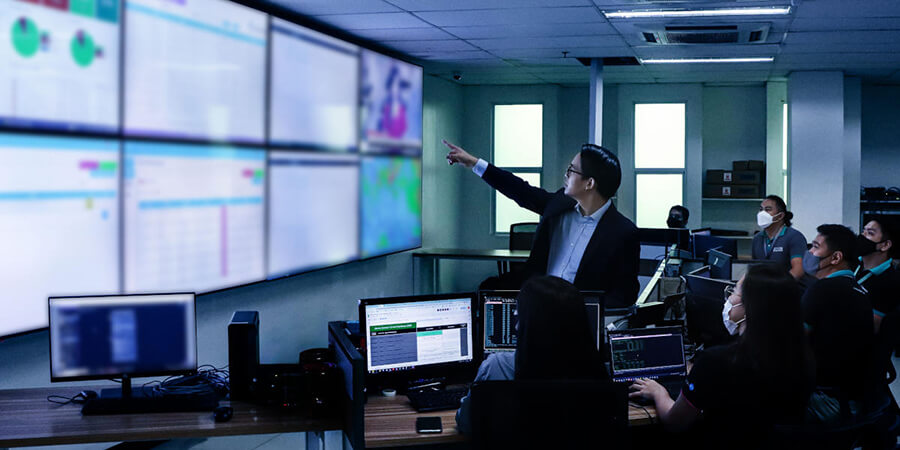Leading Philippine internet and technology solutions provider Converge ICT Solutions Inc. is ushering in a new era in network operations management as it builds a “zero-touch” network operations center. Its network is being outfitted to intuitively and automatically respond to data signals with as little human intervention as possible, which is a giant leap in network operations and maintenance.
"Now that we have the broadest fiber to the home network in the country, we want to install the best technology into the network that will make it an autonomous and self-healing network — capable of observing, monitoring and detecting faults automatically. This ensures that service interruptions to our customers are significantly reduced and outages are quickly resolved, a 180-degree turnaround from our manual processes," said Converge Chief Network Transformation Officer Paulo Martin Santos.
This end-to-end automation for the entire operational life cycle was initiated through a platform Converge calls NIAP, or the Network Intelligence and Automation Platform, which effectively injects much-needed intelligence and automation into the company's network operations.
Santos also noted that NIAP is now ingrained in network operations, from monitoring to maintenance, trouble ticketing and resolution.
"Take, for example, the day-to-day network maintenance: when a trouble event occurs in the network — for example, a fiber link is down — a deluge of alarms in the thousands comes into the system. In the past, since the equipment used by Network Operations came from different vendors, there was no single view of the alarms. With the new solution, there is a centralization of alarms in one dashboard, offering ease and convenience to engineers," he added.
Aside from this, the analysis of such trouble events includes an AI-powered correlation and compression of alarms, which lessens the thousands of alarms to a manageable number for an engineer to analyze.
From this stage, the AI powers through the process: once the source of the alarm is identified, a trouble ticket is automatically created. If there is any update to the incident, there is automatic updating to the ticket, and an advisory is made.
Moreover, NIAP has a cognitive module that translates massive events into meaningful incident patterns and root causes to run data-driven automation flows and predictive analysis, keeping a record of past events and learning from them.
In terms of operational efficiency, AI and automation allow engineers to resolve issues with one click; hence, it is called a “self-healing” network. For customer-facing departments, the platform is quickly able to display how many subscribers are affected and in which area.
"With our one-click diagnosis tool, we automate the diagnostic process and provide possible root causes for our clients, including high CPU usage, memory issues, temperature problems and low optical power," shared Jeff Briones, Network Transformation project lead.
These efficiencies also extend to field operations: work orders are applied through the platform, allowing trouble tickets to be assigned to the available engineers, and through an accompanying mobile app, their location and the status of the issue are updated in real-time. Resolutions of tickets are done quicker and more intuitively.
Santos said that since the integration of AI technology into the company's operations, the resolution time of service issues has been significantly reduced.
Landbank of the Philippines, one of the company's clients, expressed their gratitude for the improved resolution time for their service: "Thank you for the improved monitoring and incident management. Downtime and line troubleshooting time are greatly reduced, and ease of communication is better now."
The implementation of the platform has already resulted in improvements in the operating metrics. The portion of service affecting tickets relative to total network tickets declined by almost 50% in the fourth quarter of 2022. Additionally, the mean time to escalate for backbone issues has been reduced by 62%. This means from an hour to around 25 minutes.
"These recent rollouts are just a glimpse of what we have planned for the upcoming quarters. Our goal is to continuously transform the predominantly human-operated O&M into an intelligent operation through collaboration between humans and AI machines," said Briones.
"With this new and intelligent operating model driven by AI, the processing time of network faults and the cost of operations, as well as human errors, can be effectively controlled," Santos continued.
"In the future, we are looking forward to using AI to provide proactive advisory services to our customers. This will definitely give our customers a better experience, which has always been our top goal," Santos ended.
Santos said Converge constantly looks for ways to leverage technology to improve its customers' daily experiences, with reliability being one of the main focus points.
"While there are events beyond our control that impact our infrastructure, such as environmental calamities, we must ensure that our services are resilient and affected minimally in the face of these disturbances," he said.






